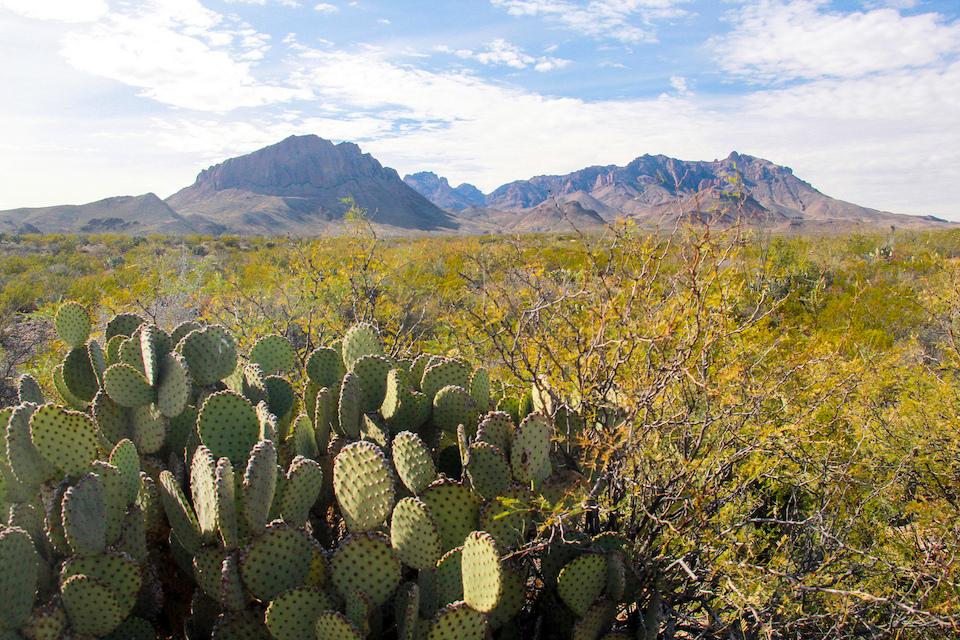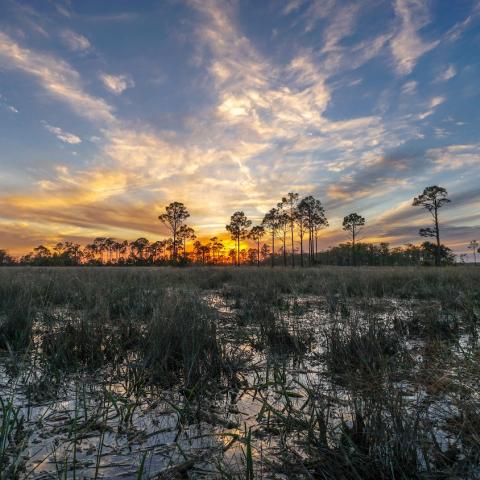
Panther Mountain (left) and the rest of the Chisos Mountains, seen from the Dugout Wells are/Robert Pahre
Editor's note: Professor Robert Pahre and his trek with students to Texas to visit several units of the National Park System coincided, unfortunately, with the partial government shutdown. It definitely was a learning experience.
Though the National Park Service makes up only one-tenth of 1 percent of the federal budget, it takes up a much larger share of the public imagination. The parks are also prominent in media coverage on the federal government. That’s especially true during one of our regular government shutdowns, when the media tells stories of closed parks, disappointed visitors, vandals, and piles of trash.
As someone who teaches in the national parks, I’m well aware of the irony of adding to that media coverage. As it turns out, however, I had a group of students from the University of Illinois who were among those disappointed visitors. Because they were taking my class on the politics of national parks, the politics of a government shutdown suddenly became part of the course agenda. Since we were on a winter break field trip to West Texas, with about half our days within sight of the border, U.S. border politics also marked the students’ experience.
I was teaching the course for the Campus Honors Program at the University of Illinois. The course included classes on campus in late fall, with students presenting papers on campus in early spring, with a field trip in the middle, during winter break. Plane tickets, hotels, and some meals were all paid in advance. In short, we were well committed to the field trip long before any threat of a partial government shutdown. We were going to Texas, and I would have to make it work. The students would have to accept the results graciously, and they did.

If you arrive from El Paso, El Capitan welcomes you to the Guadalupe Mountains.
As a rule of thumb, the park lands were “open” but the buildings were closed. The National Park Service had law enforcement on duty but no one else, as far as we saw. Fort Davis National Historic Site, where visitors spend almost all their time with the buildings, was closed entirely. So was Chamizal National Memorial in El Paso. Carlsbad Caverns, like other caves, is a “federal building,” so it would be closed to us – but hiking on the surface lands of the park was still available. Big Bend and Guadalupe Mountains were also open to hiking.
The closed buildings had a significant effect on course content. I use visitor centers and museums a lot when I teach the national parks. After all, I can’t be an expert on Permian geology, the Chihuahuan Desert ecosystem, and the Mescalero Apache. Visitor centers teach my students about each park’s resources.
Fortunately, the outdoor exhibits at Big Bend’s Fossil Discovery Center were open. We could see the inside of the store at La Harmonia, which a concessioner operates. The outside of the other buildings at Castolon were also available to visit, along with some farm equipment. They reminded us of what we were missing from the closed exhibits.
Visitor centers and museums also serve as a useful foil for my teaching, as I ask students to reflect on the histories and political concerns that shape what appears in each visitor center – and what does not. Because the parks generally don’t interpret outdoor archaeological sites, Native Americans mostly appear – when they appear – in the visitor centers. In contrast, outdoor ranches and farms remained open for visitors, as did the Castolon exteriors. As a result, the closed buildings tended to remove American Indian stories from my students’ experiences, while leaving settlers’ stories visible out-of-doors.

My students were unable to go inside Carlsbad Caverns during the government shutdown. We found things to do on the surface instead, but it was still a disappointment/Robert Pahre
The shutdown also shaped course content in some positive ways. I had originally planned to take the class to Chamizal National Memorial on the Mexican border. Because Chamizal was entirely closed, I decided to find an alternative.
El Camino Real de Tierra Adentro National Historic Trail provided an excellent choice. Like other national historic trails, it depends on partnerships with other public and private landowners, state and local governments, and non-governmental organizations. El Camino Real includes three Spanish “mission” churches in the El Paso area, though San Elizario is actually a presidio church. Those churches still have active parishes, and are owned by the Roman Catholic Diocese of El Paso – which remained open, of course. Visiting these sites let us talk about the Spanish and Mexican heritage of the Rio Grande Valley. The national historic trail also reinforced one of my planned lessons about the role of partnership between the NPS and other groups.
The heritage story resonated well with the political conflicts over the U.S. border that lay behind the government shutdown. Through the 19th century, the Indigenous and Hispanic peoples of the Rio Grande Valley did not cross the border to get where they live – the border crossed them. On the opposite end of Texas, at sites we did not visit, Anglo settlers crossed the border after Mexican independence in 1821. American citizens such as Stephen Austin responded to the incentives of Mexico’s colonization policy. As it turns out, that policy backfired on the Mexican government, resulting in the Texas Revolution, independence, and statehood.

Chamizal National Memorial, a national park unit in El Paso along the border with Mexico, is closed during the partial government shutdown. The park memorializes the 1964 agreement between the United States and Mexico to settle a border dispute that occurred when the Rio Grande (Rio Bravo del Norte) shifted its course. I was teaching a campus honors course on the national parks, and had hoped to take the students here. Instead, those with passports had lunch in Ciudad Juárez. The red X you see in the background is in Juárez, Chihuahua, México/Robert Pahre
The missions along El Camino Real de Tierra Adentro gave the students a different view of Spanish, Mexican, and Texas history than most of them had learned in high school. Had our itinerary taken us further east or south, we would have seen similar stories in San Antonio, along El Camino Real de los Tejas National Historic Trail. That other itinerary, which we had discussed as an option, would have also meant seeing the Anglo history at the Alamo, though it is not a national park unit.
When we got to Big Bend, Mexican-American border issues reappeared. We visited the U.S. side of two communities that used to straddle the border, at Castolon in the west and Boquillas in the east. We had planned to cross into Boquillas for lunch, but the NPS closed the crossing as non-essential. However, a group of burros on the Coahuiltecan side of the border grazed their way over to us. We said hello to the burros across the river. We also waved at people going about their daily business in Mexico.
While the park closures frustrated them, the students knew that the partial government shutdown affected many other people, generally in much bigger ways. They knew that federal employees were missing paychecks, contractors were losing business, and many Americans were losing essential services. The people of Boquillas also lost income since American visitors like us could not shop or eat in their town. Ours was just another small story of the effects of a government shutdown.
Robert Pahre is Professor of Political Science at the University of Illinois, where much of his teaching and research focuses on national parks and other public lands.




 Support Essential Coverage of Essential Places
Support Essential Coverage of Essential Places







Comments
Learn more about El Camino Real de Tierra Adentro National Historic Trail at: https://www.nps.gov/elca/index.htm
Thanks, Ranger Carol! I've been impressed with the sites at the El Paso and Santa Fe ends of the trail, and need to visit those in between.